Effect of Pressure Difference between Inner and Outer Gas Layer on Micro-Tube Deformation during Gas-Assisted Extrusion
Abstract
:1. Introduction
2. Modelling and Numerical Methods
2.1. Geometric and Finite Element Models
2.2. Control and Constitutive Equations
2.3. Setting of Numerical Simulation Parameters
2.4. Boundary Conditions
2.5. Evaluation Indicators
2.6. Numerical Methods
3. Simulation Results and Analysis
3.1. Results and Analysis of Micro-Tube Section Size
3.2. Results and Analysis of Velocity Fields
3.3. Results and Analysis of Pressure
3.4. Results and Analysis of Shear Rate
4. Experimental Results and Analysis
5. Conclusions
Author Contributions
Funding
Informed Consent Statement
Data Availability Statement
Conflicts of Interest
References
- Liu, T.K.; Huang, X.Y.; Liu, H.S.; Ren, Z.; Luo, C.; Wang, D.Y. Effect of air on inner air cushion of plastic microtube gas assisted extrusion. Polym. Mater. Sci. Eng. 2020, 36, 75–86. [Google Scholar] [CrossRef]
- Ren, Z.; Huang, X.Y.; Liu, H.S. Influence of gas in inner air cushion layer in gas-assisted extrusion of plastic micropipes. Mater. Guide 2020, 34, 20193–20198. [Google Scholar] [CrossRef]
- Jin, G.B.; Zhao, D.Y.; Wang, M.J.; Jin, Y.F.; Tian, H.Q.; Zhang, J. Study on design and experiments of extrusion die for polypropylene single-lumen micro tubes. Microsyst. Technol. 2015, 21, 2495–2503. [Google Scholar] [CrossRef]
- Tang, D.; Fang, W.L.; Fan, X.H.; Li, D.Y.; Peng, Y.H. Effect of die design in microchannel tube extrusion. Procedia Eng. 2014, 81, 628–633. [Google Scholar] [CrossRef]
- Jin, G.B. Research on Design and Manufacturing Technology and Extrusion Process of Polymer Micro-Extrusion Die for Interventional Medical Catheters. Ph.D. Thesis, Dalian University of Technology, Dalian, China, 2013. [Google Scholar]
- Zhu, C.W.; Wu, D.M. The design of the die for Multi-lumen precision medical catheter. Plastics 2008, 37, 99–102. [Google Scholar]
- Chen, X. The Research of Technology and Die in Continuous Extrusion of Microcellular Plastics. Ph.D. Thesis, Nanchang University, Nanchang, China, 2014. [Google Scholar]
- Zhao, D.Y.; Wang, M.J.; Song, M. Experimental study and molecular dynamics simulation of wall slip in a micro-extrusion flowing process. Mech. Eng. Sci. 2012, 225, 1175–1190. [Google Scholar] [CrossRef]
- Wei, Y.B.; Wang, M.J.; Zhao, D.Y.; Liu, K.; Shen, Z.N. Study on single-die multi-specification polylactic acid microtube extrusion molding process. Polym. Mater. Sci. Eng. 2019, 35, 95–102. [Google Scholar] [CrossRef]
- Jin, G.B.; Wang, M.J.; Zhao, D.Y.; Tian, H.Q. Experimental investigation of extrusion process of double-lumen micro tube. J. Mech. Eng. 2012, 48, 19–27. [Google Scholar] [CrossRef]
- Wang, L. Study on Extrusion Molding and Processing Parameters of Polymeric Microtubes with Rectangular Microchannels. Ph.D. Thesis, Zhejiang University, Hangzhou, China, 2020. [Google Scholar]
- Deng, X.Z.; Xiao, B.; Tang, G.; Yan, X.X.; Yu, S.F. Effect of shaping length on lolymer precision extrusion for Micro Tube. Plastics 2018, 47, 118–121. [Google Scholar]
- Deng, X.Z.; Yu, S.F.; Xiao, B.; Huang, Z.H.; Zheng, B.W. Research progress of polymer micro extrusion molding process. China Rubber/Plast. Technol. Equip. Plast. 2017, 43, 28–32. [Google Scholar]
- Zhang, H.G.; Lamnawar, K.; Maazouz, A.; Maia, J.M. A nonlinear shear and elongation rheological study of interfacial failure in compatible bilayer systems. J. Rheol. 2016, 60, 1–23. [Google Scholar] [CrossRef]
- Luo, X.L.; Mitsoulis, E. Memory phenomena in extrudate swell simulations for annular dies. J. Rheol. 1989, 33, 1307–1327. [Google Scholar] [CrossRef]
- Yao, D.; Kim, B. Simulation of the filling process in micro channels for polymeric materials. J. Micromech. Microeng. 2002, 12, 604–610. [Google Scholar] [CrossRef]
- Liu, K.; Wang, M.J.; Zhao, D.Y.; Li, H.X. Viscoelastic rheological properties of polymer melts in cross-scale extrusion processes. China Mech. Eng. 2021, 32, 1494–1503. [Google Scholar] [CrossRef]
- Wang, M.J.; Tian, H.Q.; Zhao, D.Y. Micro-scale shear viscosity testing approach and viscosity model of polymer melts. J. Mech. Eng. 2012, 48, 21–29. [Google Scholar] [CrossRef]
- Xiao, X.H. Analysis and Experimental Study of Polymer Micro Tubing Extrusion Flow. Ph.D. Thesis, Central South University, Changsha, China, 2013. [Google Scholar]
- Xiao, J.H.; Chen, S.W. Rheological properties of medical grade thermoplastic polyurethane. Polym. Mater. Sci. Eng. 2016, 32, 87–90. [Google Scholar] [CrossRef]
- Tian, H.Q.; Zhao, D.Y.; Wang, M.J.; Jin, G.B.; Jin, Y.F. Study on extrudate swell of polypropylene in double-lumen micro profile extrusion. J. Mater. Process. Technol. 2015, 225, 357–368. [Google Scholar] [CrossRef]
- Zhou, H.B.; Fan, H.H.; Zhai, Y.H.; Peng, Q. A new utility calculation model for axial flow of non-Newtonian fluid in concentric annuli. Can. J. Chem. Eng. 2014, 92, 945–952. [Google Scholar] [CrossRef]
- Kim, J.H.; Lyu, M.Y. Predictions of flow behaviors and entrance pressure drop characteristics of a rubber compound in a capillary die using various rheological models. Polym. Eng. Sci. 2014, 54, 2441–2448. [Google Scholar] [CrossRef]
- Hyvärinen, M.; Jabeen, R.; Kärki, T. The Modelling of Extrusion Processes for Polymers—A Review. Polymers 2020, 12, 1306. [Google Scholar] [CrossRef]
- Pan, J.W.; Luo, X.; Jin, B.; Xi, J.C.; Fang, K.; Zou, X.X. Numerical analysis of extrusion swelling of double-layer microtubules. China Plast. Ind. 2021, 49, 65–68. [Google Scholar] [CrossRef]
- Verbeeten, W.M.H.; Peters, G.W.M.; Baaijens, F.P.T. Differential constitutive equations for polymer melts: The extended Pom–Pom model. J. Rheol. 2001, 45, 823–843. [Google Scholar] [CrossRef]
- Cai, Z.N.; Huang, X.Y.; Liu, T.K.; Peng, Y.L. Simulation and analysis of gas-assisted extrusion of plastic microtubes in micro-scale. Eng. Plast. Appl. 2022, 50, 83–90. [Google Scholar]
- Mu, Y.; Zhao, G.Q.; Wu, X.G.; Zhai, J.Q. Finite-Element Simulation of Polymer Flow and Extrudate Swell Through Hollow Profile Extrusion Die with the Multimode Differential Viscoelastic Model. Adv. Polym. Technol. 2013, 32, 1–19. [Google Scholar] [CrossRef]
- Zhao, L.Z. Research Progress in Extrusion Swell of Polymer Melt. China Plast. 2007, 21, 1–5. [Google Scholar]
- Mu, Y.; Zhao, G.Q.; Zhang, C.R. Numerical Investigation of Viscoelastic Flow and Swell Behaviors of Polymer Melts in the Hollow Profile Extrusion Process. Adv. Mater. Res. 2010, 97, 209–213. [Google Scholar] [CrossRef]
- Xu, X.M.; Zhao, G.Q.; Qin, S.X.; Wang, W.W. Numerical Simulation of Viscoelastic Extrudate Swell Through Elliptical Ring Die. Chin. J. Chem. Eng. 2011, 19, 10–17. [Google Scholar] [CrossRef]
- Ren, Z.; Huang, X.Y.; Xiong, Z.H. Experimental and numerical studies for the gas-assisted extrusion forming of polypropylene micro-tube. Int. J. Mater. Form. 2020, 13, 235–256. [Google Scholar] [CrossRef]
- Yin, H.N.; Huang, X.Y.; Liu, T.K.; Song, M.J. Effects of gas-assisted extrusion on slip in the cable coating process. J. Polym. Eng. 2021, 41, 329–337. [Google Scholar] [CrossRef]
- Huang, X.Y.; Liu, H.S.; Zhou, G.F.; Luo, Z.M.; Li, S.Y. The Experimental Study of Air-Assisted Extrusion of Polymer. China Plasitics 2005, 19, 17–19. [Google Scholar]
- Luo, C.; Huang, X.Y.; Liu, T.K.; Liu, H.S. Research on Inner Gas Inflation Improvements in Double-layer Gas-assisted Extrusion of Micro-tubes. Polymers 2020, 12, 899. [Google Scholar] [CrossRef] [PubMed]
- Huang, C.Y.; Liu, H.S.; Huang, X.Y.; Wan, Q.F.; Ren, Z. Numerical Simulation of Gas-assisted Extrusion Process of Microtube. China Plast. Ind. 2015, 43, 44–48. [Google Scholar] [CrossRef]
- Liang, R.F.; Mackley, M.R. The gas-assisted extrusion of molten polyethylene. J. Rheol. 2001, 45, 211–226. [Google Scholar] [CrossRef]
- Ren, Z.; Huang, X.Y.; Liu, H.S.; Deng, X.Z.; He, J.T. Non-isothermal viscoelastic numerical analysis of compressible gas-assisted polymer extrusion molding. CIESC J. 2015, 66, 1615–1623. [Google Scholar] [CrossRef]
- Ren, Z.; Huang, X.Y.; Liu, H.S.; Deng, X.Z.; He, J.T. Numerical and experimental studies for gas assisted extrusion forming of molten polypropylene. J. Appl. Polym. Sci. 2015, 132, 1–13. [Google Scholar] [CrossRef]
- Liu, T.K.; Huang, X.Y.; Luo, C.; Wang, D.Y. The Formation Mechanism of the Double Gas Layer in Gas-Assisted Extrusion and Its Influence on Plastic Micro-Tube Formation. Polymers 2020, 12, 355. [Google Scholar] [CrossRef] [Green Version]
- Liu, T.K.; Huang, X.Y.; Ren, Z.; Luo, C.; Tan, J.M. Analysis of Superimposed Influence of Double Layer Gas Flow on Gas-Assisted Extrusion of Plastic Micro-Tube. Int. Polym. Proc. 2020, 35, 158–168. [Google Scholar] [CrossRef]
- Yu, B.; Yang, Z.Y. Application of Computer Simulation Technology in Extrusion Molding Process of Micro Plastic Pipe. China Plast. Ind. 2017, 45, 69–72. [Google Scholar] [CrossRef]
- Phan, T.; Tanner, R. A new constitutive equation derived from network theory. J. Non-Newton. Fluid Mech. 1977, 2, 353–365. [Google Scholar] [CrossRef]
- Deng, X.Z. Experimental and Theoretical Study on Gas-Assisted Co-Extrusion of Plastic Profile with an Irregular Cross-Section. Ph.D. Thesis, Nanchang University, Nanchang, China, 2014. [Google Scholar]
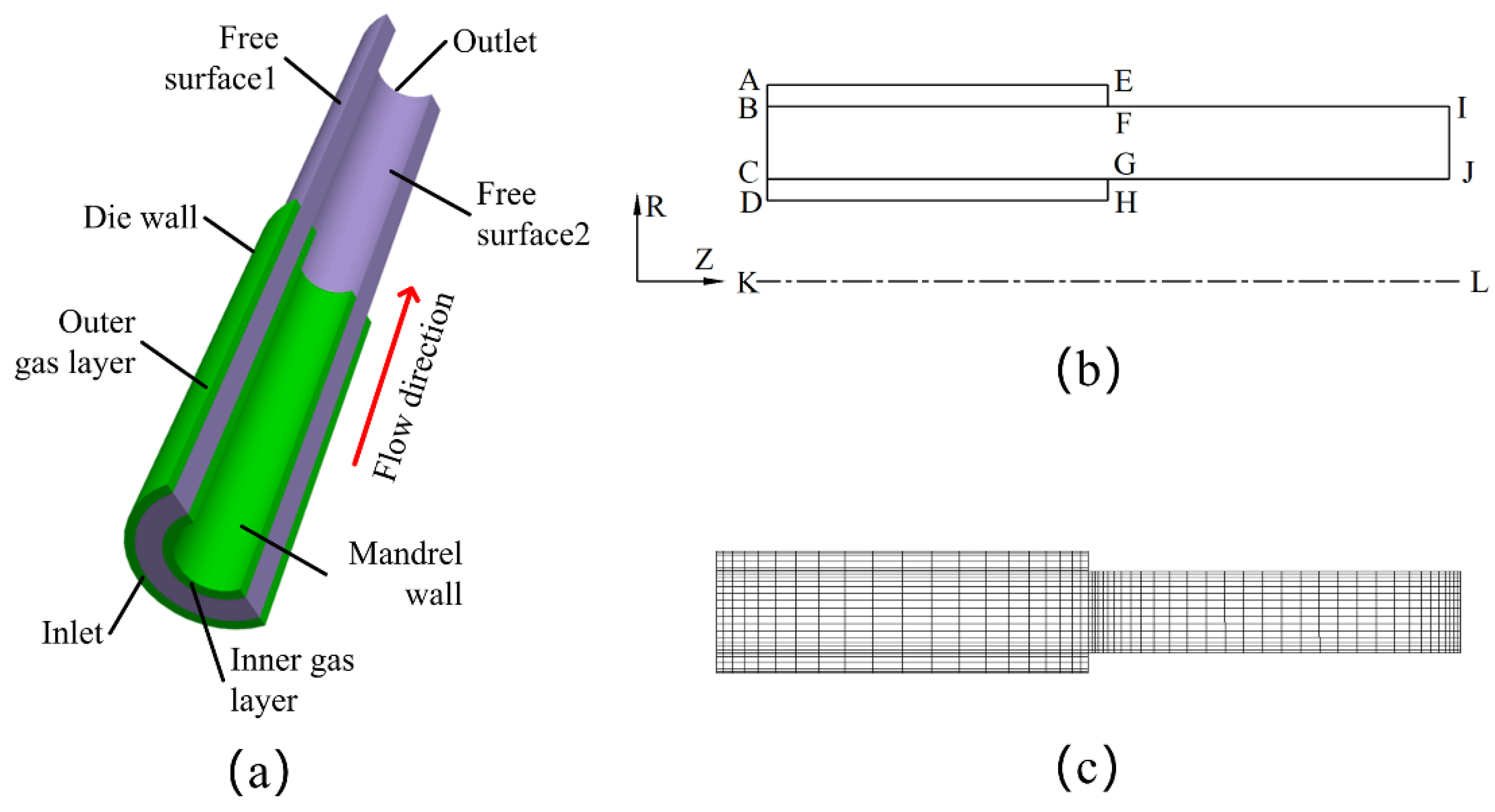
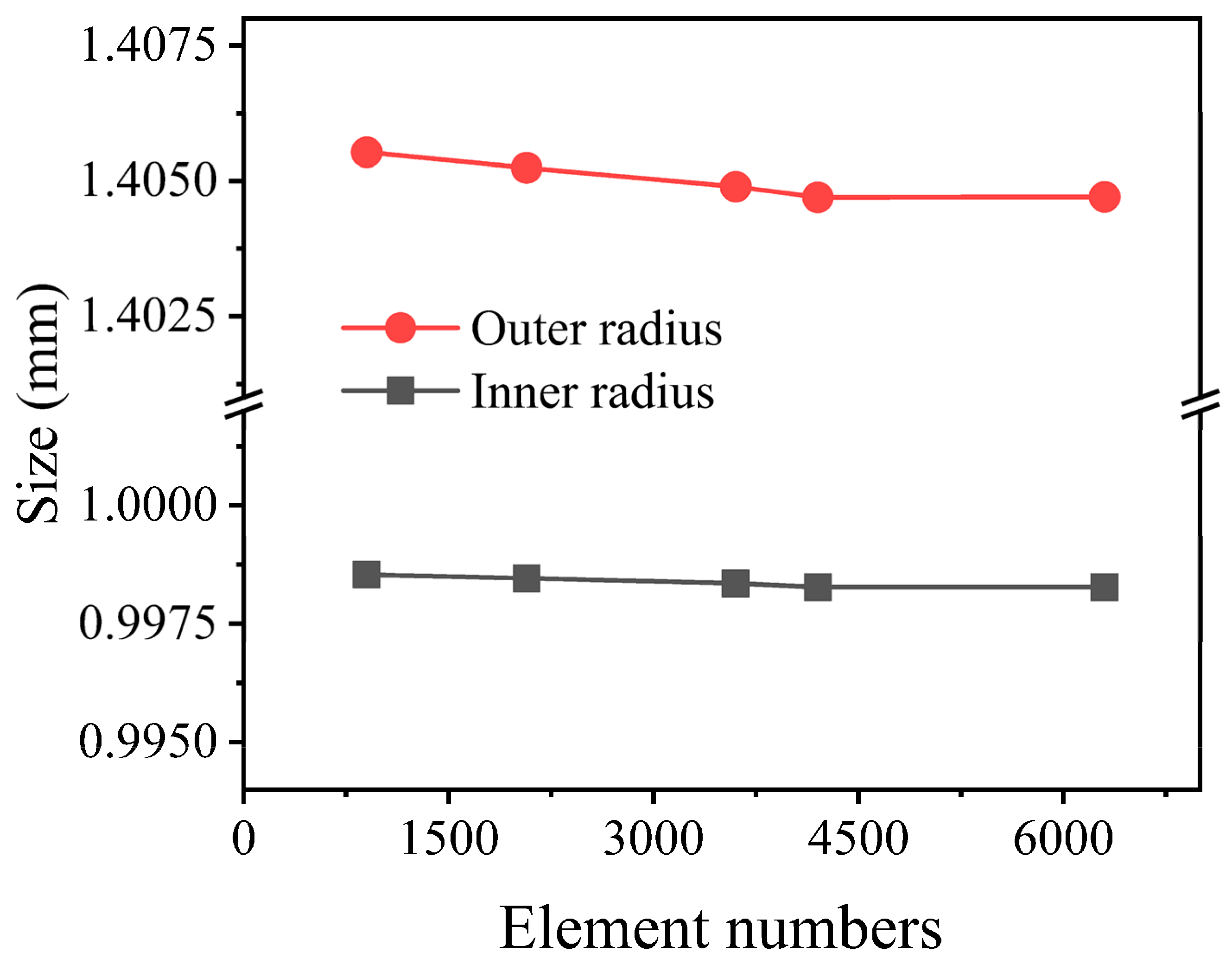

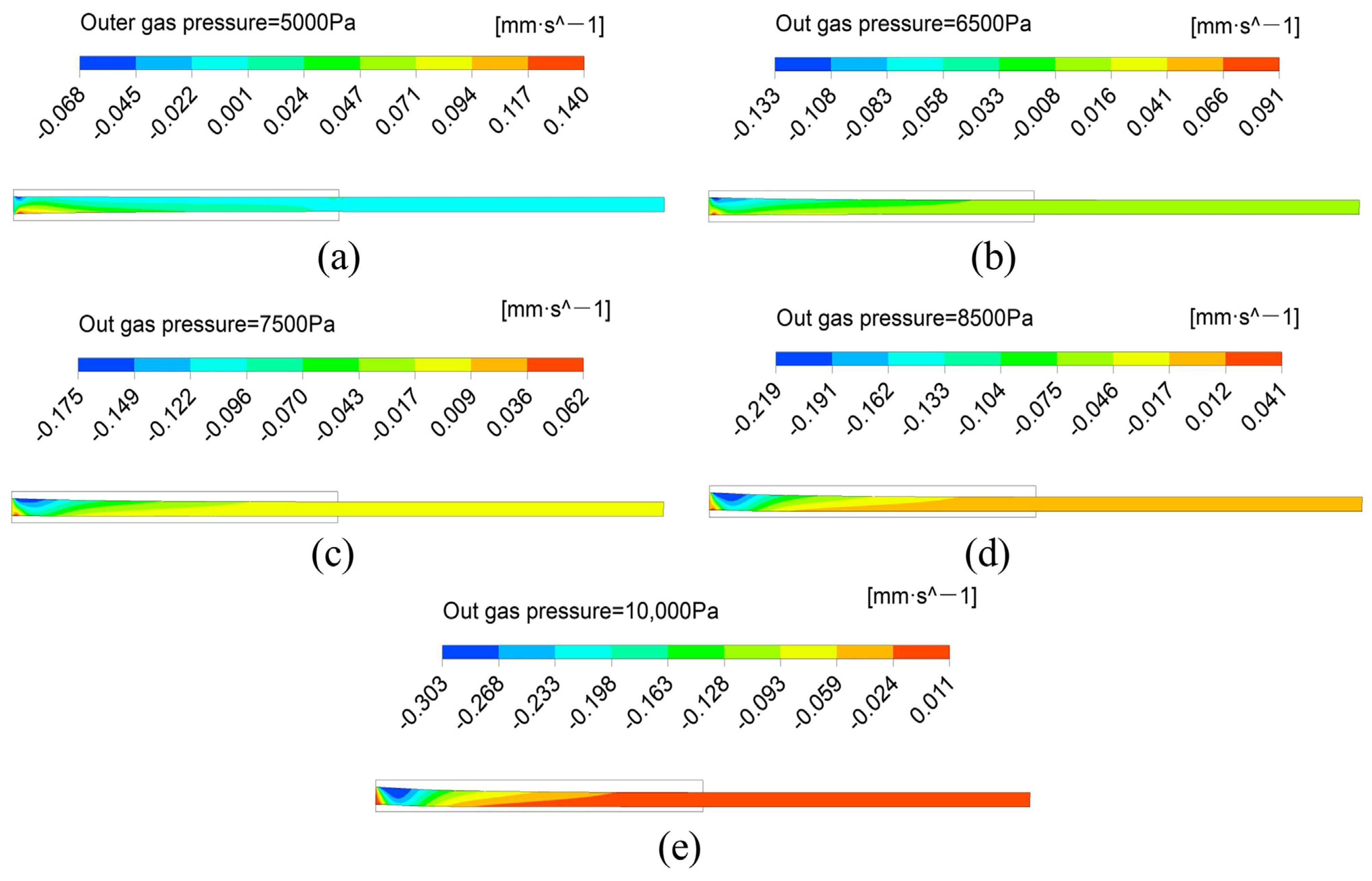

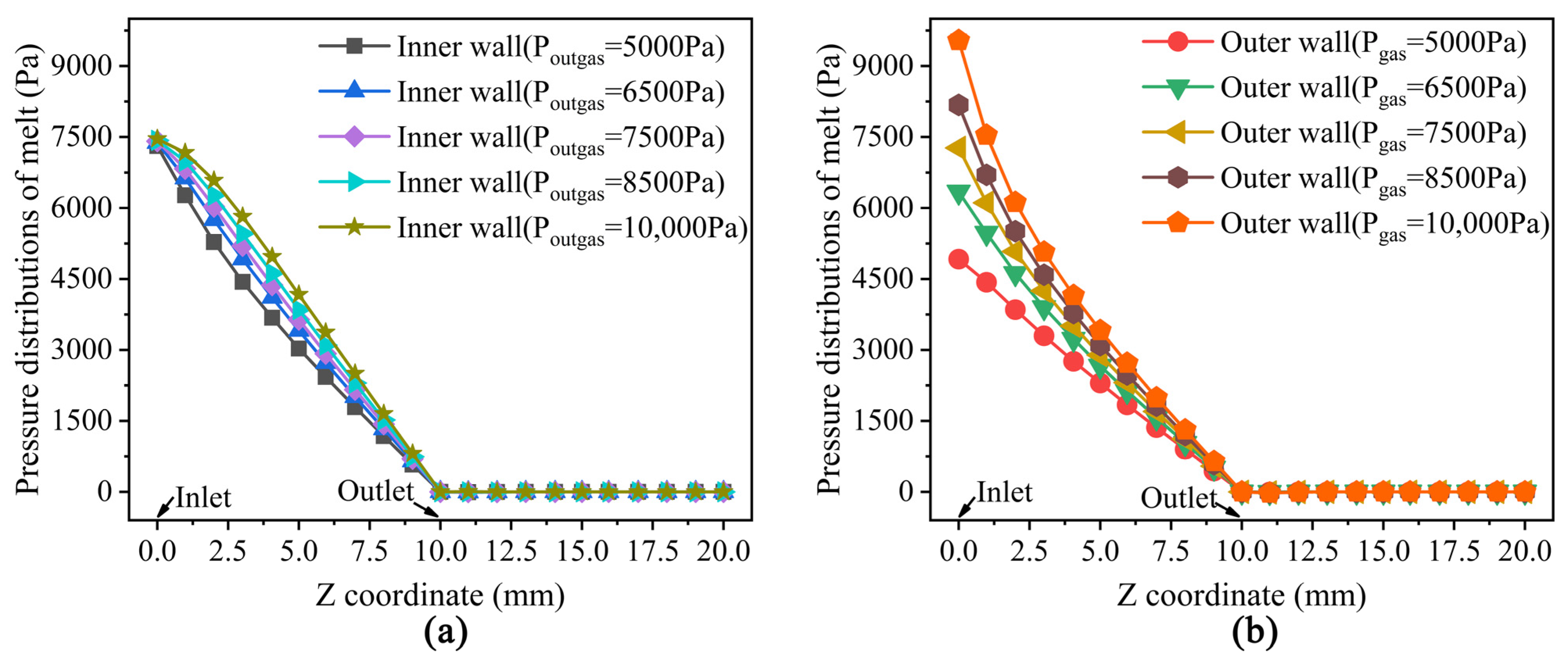
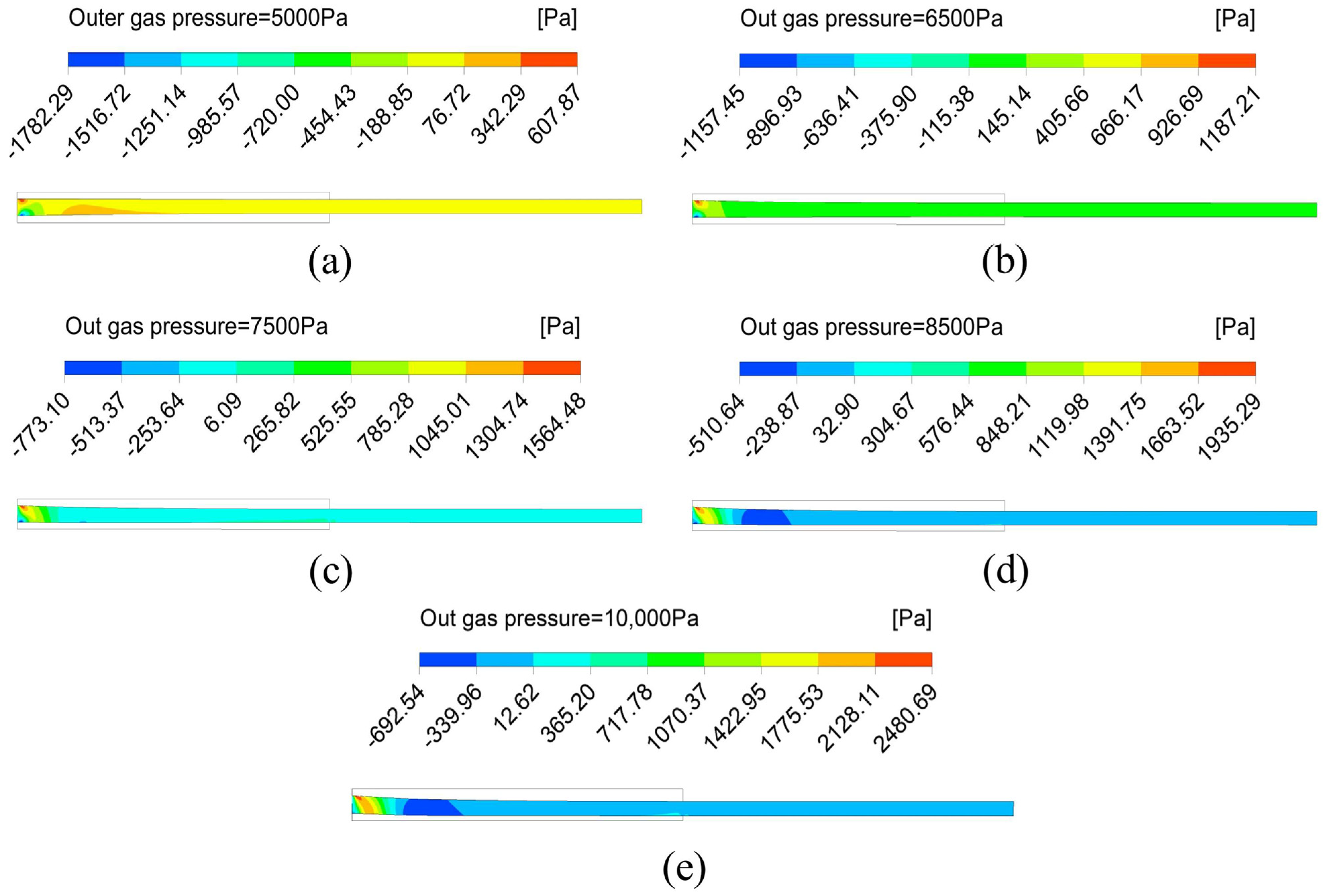
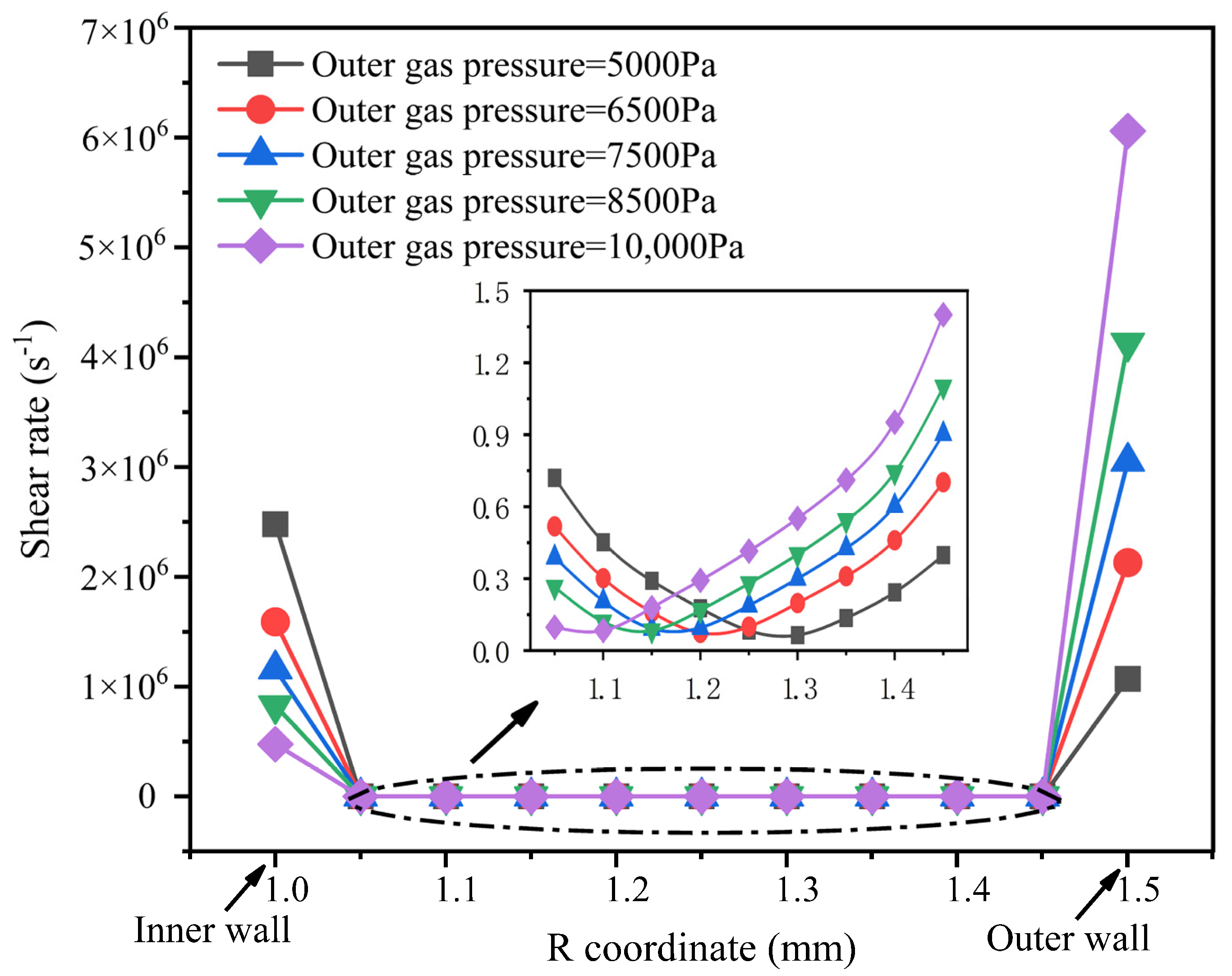
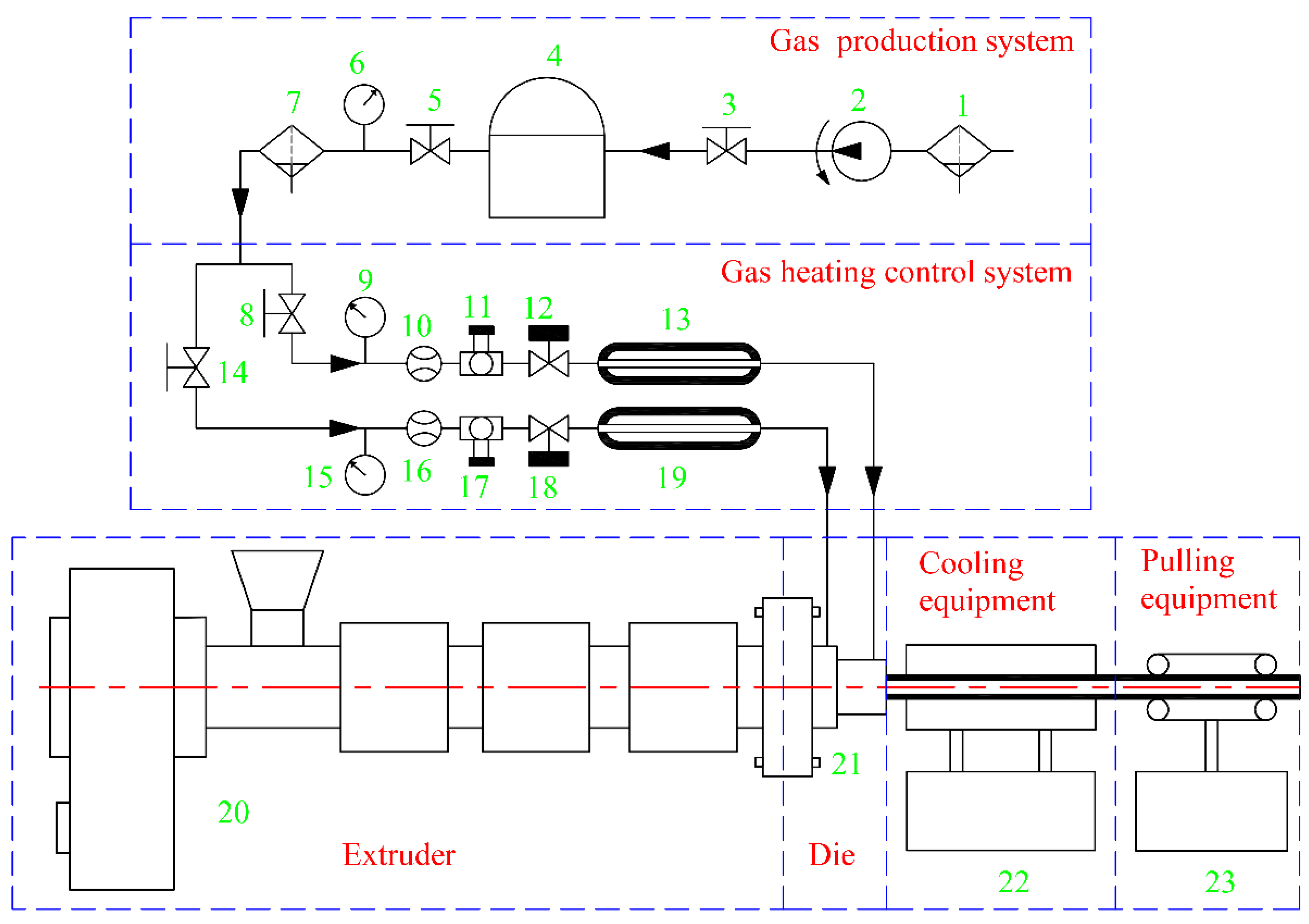
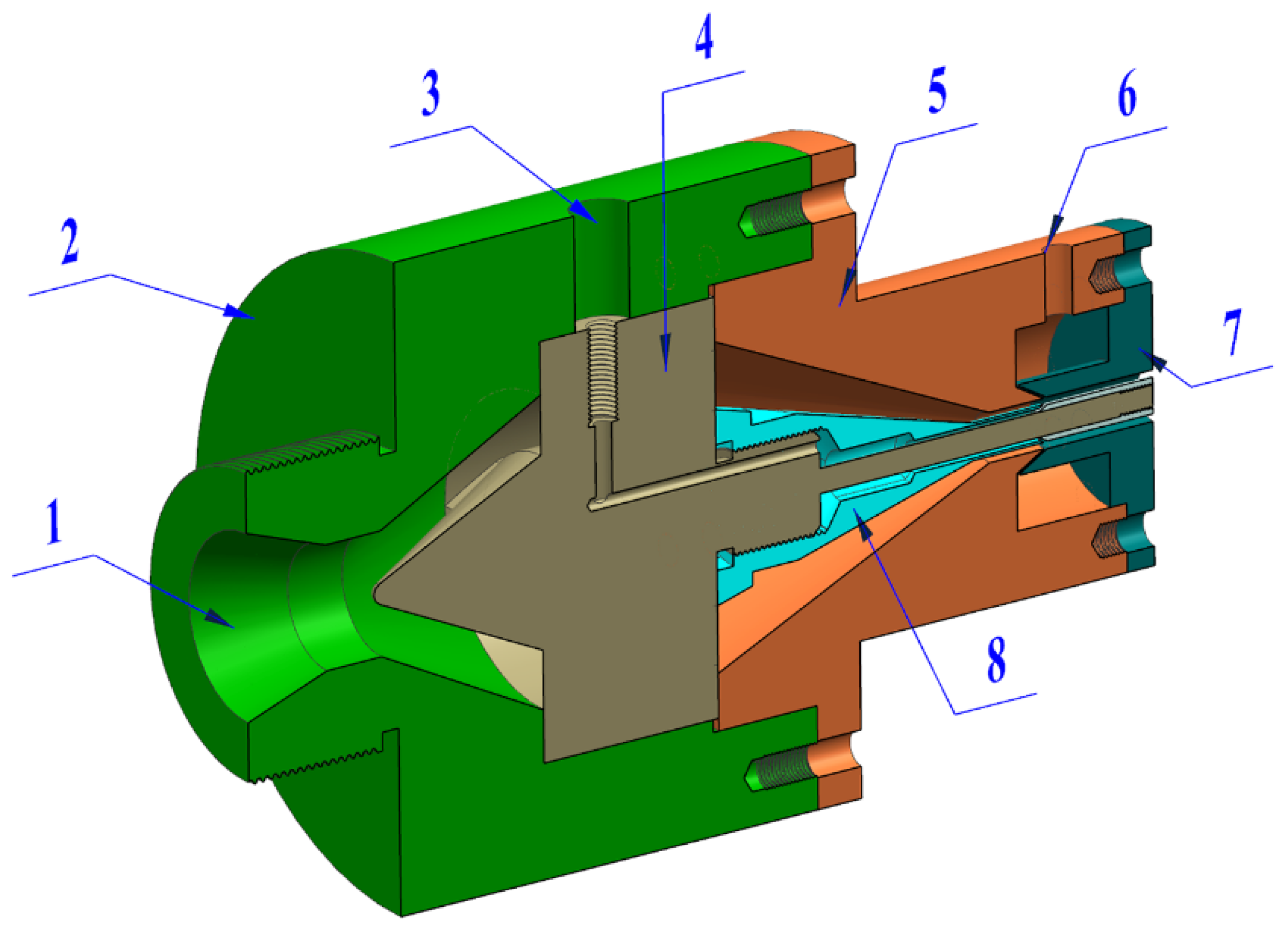

| Equation Parameters | Melt | Gas |
|---|---|---|
| /(Pa s) | 8823 | |
| /(s) | 0.1 | 0 |
| 0.15 | 0 | |
| 0.44 | 0 | |
| 0.12 | 0 | |
| 0.22 | 0.037 | |
| 1883 | 0.037 |
| Experimental Conditions | Gas-Assisted Extrusion | Non-Gas-Assisted Extrusion |
|---|---|---|
| Inner gas Pressure/(Pa) | 7500 | 0 |
| Outer gas Pressure/(Pa) | 6500\7500\10,000 | 0 |
| Traction device frequency/(Hz) | 4 | 4 |
| Temperature of the die/(°C) | 200 | 200 |
| Extruder motor frequency/(Hz) | 4 | 4 |
Publisher’s Note: MDPI stays neutral with regard to jurisdictional claims in published maps and institutional affiliations. |
© 2022 by the authors. Licensee MDPI, Basel, Switzerland. This article is an open access article distributed under the terms and conditions of the Creative Commons Attribution (CC BY) license (https://creativecommons.org/licenses/by/4.0/).
Share and Cite
Liu, B.; Huang, X.; Ren, S.; Luo, C. Effect of Pressure Difference between Inner and Outer Gas Layer on Micro-Tube Deformation during Gas-Assisted Extrusion. Polymers 2022, 14, 3559. https://doi.org/10.3390/polym14173559
Liu B, Huang X, Ren S, Luo C. Effect of Pressure Difference between Inner and Outer Gas Layer on Micro-Tube Deformation during Gas-Assisted Extrusion. Polymers. 2022; 14(17):3559. https://doi.org/10.3390/polym14173559
Chicago/Turabian StyleLiu, Bin, Xingyuan Huang, Shaoyi Ren, and Cheng Luo. 2022. "Effect of Pressure Difference between Inner and Outer Gas Layer on Micro-Tube Deformation during Gas-Assisted Extrusion" Polymers 14, no. 17: 3559. https://doi.org/10.3390/polym14173559
APA StyleLiu, B., Huang, X., Ren, S., & Luo, C. (2022). Effect of Pressure Difference between Inner and Outer Gas Layer on Micro-Tube Deformation during Gas-Assisted Extrusion. Polymers, 14(17), 3559. https://doi.org/10.3390/polym14173559






